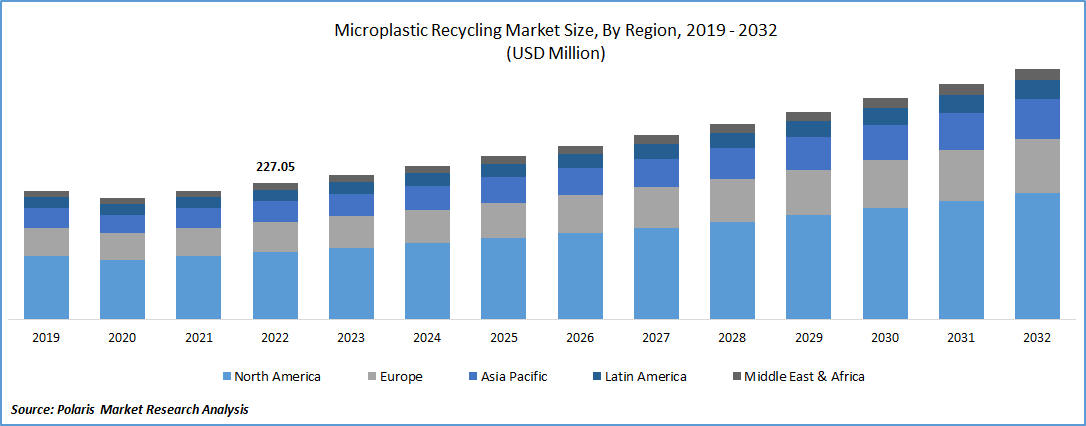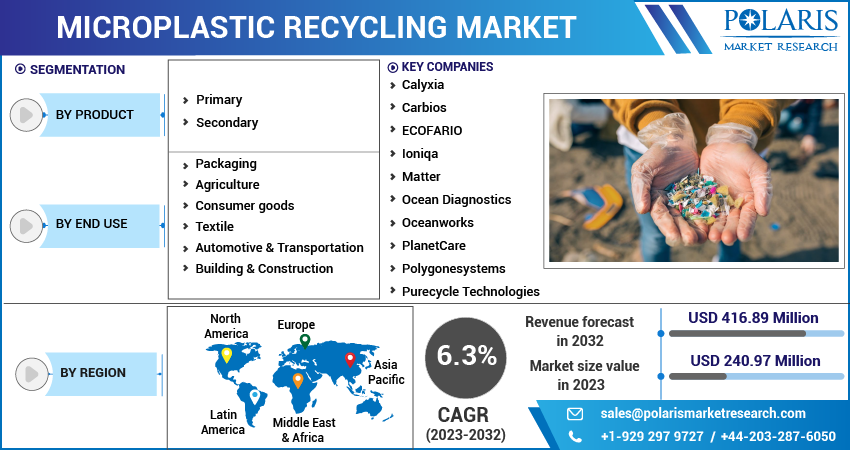
Microplastic Recycling Market Share, Size, Trends, Industry Analysis Report
By Product (Primary, Secondary), By End-use (Packaging, Agriculture, Consumer Goods, Textile, Automotive & Transportation), By Region, And Segment Forecasts 2023 - 2032
- Published Date:Aug-2023
- Pages: 119
- Format: PDF
- Report ID: PM3706
- Base Year: 2022
- Historical Data: 2019-2021
Report Outlook
The global microplastic recycling market was valued at USD 227.05 million in 2022 and is expected to grow at a CAGR of 6.3% during the forecast period.
The market is expected to experience growth in the forecast period due to government regulations, environmental awareness, technological advancements, increased consumer knowledge, and the widespread use of microplastics in various sectors. The United States is leading the way in microplastic recycling research and development, making it a significant driver of the market in the country. Manufacturers are continuously innovating new technologies and processes to improve the efficiency and cost-effectiveness of microplastic recycling. Moreover, United States manufacturers are committed to achieving sustainability goals, which has led to a surge in demand for recycled plastic, including microplastics.

To Understand More About this Research: Request a Free Sample Report
Apart from the environmental advantages, the increasing need for sustainable practices has propelled the demand for recycled materials across different sectors. End-use industries such as transportation, automotive, packaging, consumer goods, textiles, and others are actively searching for recycled microplastics to achieve their sustainability targets and minimize their carbon footprint. The growing demand from these industries creates profitable opportunities for microplastic recycling businesses, further fueling market growth.

For Specific Research Requirements, Request for a Customized Report
Industry Dynamics
Growth Drivers
Rising implementation of regulations by governments worldwide
Governments worldwide are implementing regulations to reduce plastic waste, driving the microplastic recycling market. These regulations aim to promote sustainable practices and reduce environmental impact. Consumers are also increasingly aware of the harmful effects of plastic waste on the environment and actively seeking sustainable products and services made from recycled materials. As a result, the demand for recycled products, including microplastics, is growing, leading to market growth.
Recycling microplastics is not only environmentally sustainable, but it also presents economic benefits for businesses. Companies can generate revenue and reduce production costs by repurposing and reusing microplastics instead of solely producing new plastic materials. The accumulation of microplastics in landfills and oceans is a growing concern as it harms ecosystems and marine life. Recycling microplastics reduces the amount of plastic waste that ends up in these environments, minimizing the overall impact on the environment.
Report Segmentation
The market is primarily segmented based on product, end use, and region.
|
By Product |
By End Use |
By Region |
|
|
|
To Understand the Scope of this Report: Speak to Analyst
By Product
Secondary segment held the significant market share in 2022
The secondary segment held a significant market share. This segment focuses on recycling used and discarded microplastics, such as plastic bottles, packaging, and other plastic waste. The process of secondary microplastic recycling offers several environmental benefits. Recovering and recycling microplastics minimizes the amount of plastic waste that would otherwise end up in landfills, oceans, and other natural environments. This helps reduce plastic pollution's negative impact on ecosystems and wildlife.
In addition to the environmental advantages, secondary microplastic recycling can also be cost-effective. Recycled materials are often less expensive than virgin materials, making them an attractive option for businesses seeking to reduce production costs. Companies can save on raw material expenses by utilizing recycled microplastics while still meeting their manufacturing needs.
Microbeads derived from the personal care industry serve as a feedstock in the market. These small plastic particles, commonly found in products like exfoliating scrubs & toothpaste, have raised concerns due to their environmental impact. However, with advancements in recycling technologies, it is possible to filter out microbeads from waste streams and change them into recycled materials.
In addition, using recycled microbeads can give manufacturers a competitive edge in fulfilling the demand for sustainable products. With growing awareness about the environmental impact of plastics, consumers are increasingly seeking products made from recycled materials. By incorporating recycled microbeads into their products, manufacturers can demonstrate their commitment to sustainability and attract environmentally conscious consumers.
By End-Use
Packaging segment is projected to hold substantial market share during forecast period
The packaging segment is projected to account for a substantial market share in revenue over the anticipated period. This significant market share can be attributed to the industry's increasing focus on sustainable and eco-friendly packaging solutions. Government regulations and growing consumer awareness regarding environmental issues have prompted the packaging industry to adopt more sustainable practices. As a result, there is a growing demand for packaging materials that minimize the environmental impact, and recycled plastics, including microplastics, have gained prominence in this context.
By incorporating recycled microplastics into packaging materials, companies can reduce their reliance on virgin plastics and contribute to the circular economy. Recycled plastics offer similar functionality and performance as virgin plastics but with a reduced environmental footprint. This shift towards sustainable packaging aligns with government regulations that aim to reduce plastic waste and promote a more sustainable approach to packaging.
In response to environmental concerns and the need for improved fuel efficiency, automotive manufacturers are increasingly prioritizing the reduction of vehicle weight. By reducing vehicle weight, emissions can be lowered, and fuel efficiency can be improved, contributing to a more sustainable automotive industry. These can be effectively utilized to manufacture interior components in automobiles, such as seating, door panels, & dashboard panels. These components often require lightweight materials that maintain structural integrity and durability. By incorporating recycled microplastics into the manufacturing process, automotive manufacturers can achieve weight reduction while utilizing sustainable materials.
Regional Analysis
Europe region dominated the global market in 2022
Europe dominated the global market with a substantial share in 2022; This dominance can be attributed to the stringent regulations implemented by the European Union (EU) concerning single-use plastics and waste management. The EU has been at the forefront of promoting sustainability and a circular economy through initiatives such as the EU Circular Economy Package. The EU Circular Economy Package aims to transition to a more sustainable and resource-efficient economy by promoting recycling, reducing waste generation, and encouraging using recycled materials. Microplastic recycling plays a vital role in achieving these objectives. As part of its commitment, the EU has set a target of nearly 55 percent to recycle plastic waste by 2030.
By focusing on microplastic recycling, the EU aims to mitigate the environmental impact of plastic waste and promote the reuse of valuable resources. Microplastics, including those derived from packaging materials, can be efficiently recovered and recycled into new products, reducing the need for virgin plastics and minimizing waste generation.
North America region is likely to emerge as the fastest-growing region with a healthy CAGR. In response to this issue, the region's governments have implemented regulations to reduce plastic waste and promote recycling practices. An example of such regulations is seen in California, where a law was enacted in January 2022 that mandates manufacturers to incorporate a minimum amount of recycled plastic in their products. The specific law in California focuses on plastic beverage containers and requires manufacturers to include at least 15% recycled content in these containers.
Competitive Insight
In order to remain competitive and meet evolving end-user demands, companies are actively engaged in research and development endeavors to create innovative industrial plastics. These research activities aim to develop new materials that possess a combination of desired properties, thus catering to a broader range of applications. The industry anticipates significant acceptance and adoption of these novel materials in the years ahead as they offer enhanced performance and versatility in meeting diverse market requirements.
Some of the major players operating in the global market include:
- Calyxia
- Carbios
- ECOFARIO
- Ioniqa
- Matter.
- Ocean Diagnostics
- Oceanworks
- PlanetCare
- Polygonesystems
- Purecycle Technologies
Recent Developments
- In February 2023, The REMEDIES project, funded by the European Union and valued at around USD 8.8 million, set an ambitious goal of collecting over 400 tons of microplastic. This project aims to address the issue of microplastic pollution in various Mediterranean regions by developing advanced systems for recycling, collecting, monitoring, and converting the extracted waste into new products. The primary objective of the REMEDIES project is to establish a sustainable model that effectively mitigates the impact of microplastics.
Microplastic Recycling Market Report Scope
|
Report Attributes |
Details |
|
Market size value in 2023 |
USD 240.97 million |
|
Revenue forecast in 2032 |
USD 416.89 million |
|
CAGR |
6.3% from 2023 – 2032 |
|
Base year |
2022 |
|
Historical data |
2019 – 2021 |
|
Forecast period |
2023 – 2032 |
|
Quantitative units |
Revenue in USD million and CAGR from 2023 to 2032 |
|
Segments covered |
By Product, By End Use, By Region |
|
Regional scope |
North America, Europe, Asia Pacific, Latin America; Middle East & Africa |
|
Customization |
Report customization as per your requirements with respect to countries, region and segmentation. |
FAQ's
The microplastic recycling market report covering key segments are product, end use, and region.
Microplastic Recycling Market Size Worth $416.89 Million By 2032.
The global microplastic recycling market is expected to grow at a CAGR of 6.3% during the forecast period.
Europe is leading the global market.
key driving factors in microplastic recycling market are rising implementation of regulations by governments worldwide.
